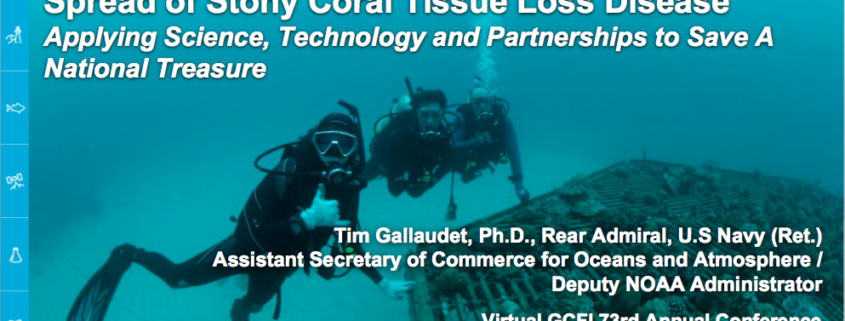NOAA Launches New Stony Coral Tissue Loss Disease Strategy at 73rd Annual Gulf and Caribbean Fisheries Institute
November 18, 2020 – For the first time in its 73-year history, the Gulf and Caribbean Fisheries Institute (GCFI) took its annual meeting fully online in 2020. The keynote opening address was delivered by Rear Admiral Tim Gallaudet, PhD, U.S. Navy (Ret.), Assistant Secretary of Commerce for Oceans and Atmosphere and Deputy Administrator of NOAA. The keynote marked the launch of the new NOAA strategy to respond to and prevent stony coral tissue loss disease.
Since 2014, Florida’s coral reefs have been severely impacted by a newly documented coral disease. Called stony coral tissue loss disease because it affects only hard corals and is characterized by the rapid loss of live coral tissue, the disease has now been reported in 16 Caribbean countries and territories.
“GCFI’s mission is to provide a forum for the exchange and dissemination of information on marine natural resource issues. Increasingly, we’re providing a forum for communications about emerging issues – like invasive lionfish, the pelagic sargassum influx and now stony coral tissue loss disease,” commented Acting Chair of GCFI and Coordinator of MPAConnect, Ms. Emma Doyle.
“Responding to a need to share information about stony coral tissue loss disease with managers in the Gulf of Mexico and Caribbean region, last year’s GCFI72 meeting was the first time that a GCFI technical session was dedicated to this emerging issue. This year, GCFI was honored to have a keynote address from NOAA about stony coral tissue loss disease that is so relevant and up to the minute in applying science, technology, cooperation and communications to save coral reefs”.
The new strategy presented by Rear Admiral Gallaudet is an agency-wide effort to develop a five-year implementation plan for responding to stony coral tissue loss disease in U.S. waters. He explained how the strategy aligns with NOAA’s strategic objectives, and highlighted the need for research and the important role of partnerships in implementation of the strategy.
“The strategy matches agency capacity with disease response needs and complements the efforts of our disease response partners in the U.S. and broader Caribbean region. It identifies how NOAA can apply its expertise to this response effort and determines actions that fall within capabilities to support both our mission and the goals outlined in the strategy,” explained the Admiral.
“The new strategy brings together goals related to research and data collection on stony coral tissue loss disease, goals to preserve the genetic diversity of corals for future coral restoration efforts, goals to raise awareness and understanding of the coral disease, to support citizen science and for strengthening and expanding partnerships. It also considers preventing the spread of the coral disease to other regions, including other U.S. coral reef jurisdictions, such as the Freely Associated States in the Indo-Pacific region,” he added.
Rear Admiral Gallaudet took questions from the audience including on potential partnerships with divers, fishers, citizen scientists and the tourism sector, about ongoing research into causes and impacts of the disease, and plans for the execution and funding of the strategy. The Q&A session highlighted existing materials and best practice protocols that are available at www.gcfi.org and https://www.agrra.org/coral-disease-outbreak/
The live keynote address was attended by an audience of some 150 participants from the Caribbean region and around the world. A full recording of the opening ceremony and keynote address is now available online at the Gulf and Caribbean Fisheries Institute’s YouTube channel, please click here.
“GCFI is pleased to share this recording of the new NOAA strategy as a resource for coral reef managers in other countries and territories in the Caribbean region as they plan their own response to stony coral tissue loss disease. We can’t emphasize enough the importance of strategically approaching local response to this new coral disease,” commented Ms. Doyle.
“A planned response enables managers to coordinate outreach among partners in order to help prevent, detect and correctly identify stony coral tissues loss disease. Local action plans prioritize coral reefs for monitoring, treatment and rescue so that effort can be targeted where it will bring greatest benefit for coral reef conservation. And locally tailored response strategies are all the more important given limited funding for conservation and the reality of finite technical resources that agencies can dedicate to this new threat,” she added.
The MPAConnect network, a partnership initiative between GCFI, NOAA’s Coral Reef Conservation Program and 32 Caribbean marine protected areas, has taken a regional lead in building management capacity for the detection of and response to stony coral tissues loss disease. MPAConnect is working to bring additional new resources to help support proactive monitoring and outreach in the Caribbean region. For more information please contact [email protected].
For a recording of the Keynote Address by Rear Admiral Tim Gallaudet, PhD, U.S. Navy (Ret.) at the virtual opening of GCFI73, see https://youtu.be/qXjt-HjJaAk)
About GCFI: The Gulf and Caribbean Fisheries Institute (GCFI) was founded in 1947 to promote the exchange of current information on the use and management of marine resources in the Gulf and Caribbean region. From its beginning, GCFI has endeavored to involve scientific, governmental, non-governmental, academic, and commercial sectors to provide a broad perspective on relevant issues, and to encourage dialogue among groups that often operate in relative isolation from one another. GCFI is a 501 (c) (3) non-profit corporation governed by a Board of Directors elected by and from its membership. All Officers and Board members serve GCFI on a volunteer basis.





Leave a Reply
Want to join the discussion?Feel free to contribute!